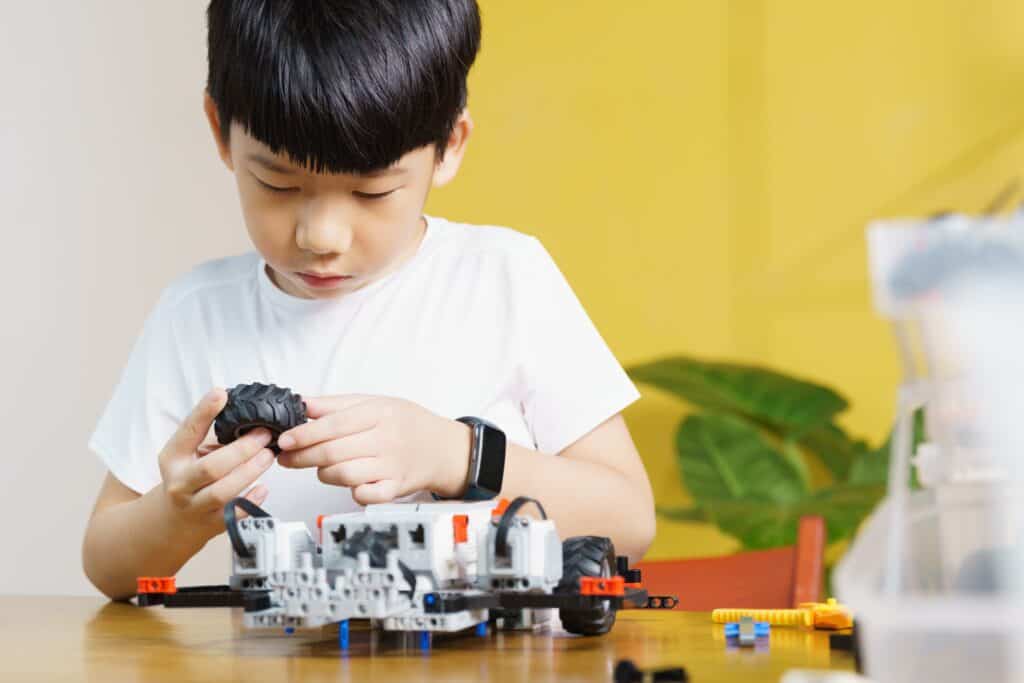Teaching Kids Problem-Solving Skills
Teaching kids problem-solving skills is incredibly important for their development. From early childhood through adulthood, the ability to assess challenges, think critically, and navigate obstacles is essential for success in school, relationships, and everyday life. Yet, in today’s world, children often have fewer opportunities to work through problems on their own. With structured schedules, instant access to information, and parents who understandably want to help, many kids don’t get enough practice in independent problem-solving.

Play. Learn. Thrive.™ only endorses products we authentically love and use. Some of the product links in this post may be affiliate links. That means that if you click them and make a purchase, this site makes a commission. Play. Learn. Thrive.™ is also an Amazon Associate. As an Amazon Associate, we earn from qualifying purchases. It will have no impact on the price you pay or the experience of your purchase.
Welcome back to Play. Learn. Thrive, a blog dedicated to helping you raise confident, lifelong learners. I’m Alanna Gallo, a former teacher with a master’s in education who saw firsthand how kids were losing confidence, independence, and their natural love of learning.

I left the classroom to help parents raise curious, capable, and screen-conscious kids in a world that doesn’t make it easy. My work has been featured in major media outlets, and I’m here to give you real, research-backed advice—without the guilt trips or unrealistic expectations.
Why Problem-Solving Skills Matter
When children develop strong problem-solving skills, they build confidence in their ability to handle challenges. Instead of feeling frustrated or helpless when faced with a difficult situation, they learn to think through their options and take action. This ability not only helps them in academics but also fosters emotional resilience, social intelligence, and creativity.
As parents, it’s natural to want to step in and make things easier when our children struggle. But by allowing kids to work through challenges on their own—with the right support—we empower them to become independent thinkers and decision-makers.
Encouraging Independent Thinking
One of the simplest ways to help children develop problem-solving skills is to encourage them to think for themselves. When a child asks for help with a problem, it can be tempting to provide an immediate solution. Instead, consider guiding them through the process by asking open-ended questions.
Rather than giving an answer right away, try asking:
- “What do you think you should do?”
- “What’s another way you could try to solve this?”
- “What do you think will happen if you try that?”
This approach shifts the responsibility back to the child, allowing them to develop confidence in their own ability to find solutions. Even if they don’t come up with the perfect answer right away, the process of thinking through possibilities is valuable in itself.
For example, if a child is struggling to build a tower of blocks that keeps falling over, instead of fixing it for them, ask questions like, “Why do you think the tower keeps falling? What could you do to make it stronger?” This helps them engage with the problem, test different ideas, and build resilience through trial and error.

Fostering a Growth Mindset
Children who believe that intelligence and abilities can grow with effort are more likely to persevere through challenges. This belief, known as a growth mindset, helps children see obstacles as opportunities to learn rather than as signs of failure.
To foster a growth mindset in problem-solving, parents can:
- Praise effort rather than results by saying, “I love how you kept trying different ways to solve that puzzle,” rather than just, “You did it!”
- Normalize struggle by reminding children that learning new things takes time and effort.
- Share personal experiences of perseverance by saying, “I used to struggle with this too, but I figured it out by trying different approaches.”
When children view challenges as something they can overcome with persistence, they are more likely to tackle problems with confidence. This mindset not only helps them academically but also encourages resilience in all aspects of life.
Using Everyday Challenges as Learning Opportunities
Problem-solving isn’t just something that happens in school. It is a skill that children can practice every day in real-life situations. Parents can encourage problem-solving by giving children opportunities to make decisions and work through challenges in their daily routines.
Some simple ways to integrate problem-solving into daily life include:
- Asking children to help plan a family outing by considering the best way to fit in different activities.
- Letting children decide what to wear based on the weather instead of telling them what to put on.
- Encouraging children to come up with a fair way to take turns with a sibling or friend.
When children are given the opportunity to solve real-world problems, they gain confidence in their ability to think through challenges and make decisions. Even small decisions, like figuring out how to clean up a spill or deciding how to fix a broken toy, help build important problem-solving skills.

Encouraging Open-Ended Play
Play is one of the most effective ways for children to develop problem-solving skills. When kids engage in unstructured, open-ended play, they naturally encounter small challenges that require creative thinking.
Building with blocks, for example, requires children to think about balance and stability. Pretend play, such as running a play restaurant, encourages them to think through how to take orders, serve food, and manage imaginary customers. Even simple outdoor play, like figuring out how to build a shelter out of sticks, helps children learn through trial and error.
Instead of giving step-by-step instructions on how to complete an activity, parents can step back and allow children to experiment. If a child is building something with LEGO, for example, resist the urge to show them how to do it. Instead, ask, “What do you think would make this structure stronger?” This approach encourages problem-solving and creativity rather than simply following instructions.
Modeling Problem-Solving in Real Life
Children learn problem-solving not just by doing but also by observing. When parents model problem-solving in everyday situations, children see how challenges can be approached calmly and logically.
Parents can think out loud when solving everyday problems, such as:
- “I forgot to buy an ingredient for dinner. What can I use instead?”
- “Our schedule is really busy today—how can we make everything work?”
- “The Wi-Fi isn’t working. What should I do first to fix it?”
By narrating the process, parents demonstrate that problems can be approached with a step-by-step mindset. This helps children see that obstacles are a normal part of life and that there are always different ways to find solutions.
Problem-Solve Without Depending on Screen-Time

50 Simple Screen-Free Learning Activities for Curious Kids
These 50 hands-on activities help children develop problem-solving skills, creativity, and real-world knowledge—without needing a screen. Designed to encourage self-directed play, hands-on discovery, and deep learning, this guide gives you a simple way to turn everyday moments into powerful learning opportunities.
Helping Kids Manage Frustration While Problem-Solving
One of the biggest roadblocks to problem-solving is frustration. When children become overwhelmed by emotions, it can be difficult for them to think clearly and work through a challenge. Parents can help by teaching strategies for managing frustration before jumping to a solution.
If a child becomes upset while trying to solve a problem, try:
- Validating their feelings by saying, “I see that you’re really frustrated. That’s okay.”
- Encouraging a pause and a deep breath before trying again.
- Helping them break the problem into smaller steps by asking, “What’s the first thing we need to do?”
For example, if a child is struggling to put on their shoes and starts getting frustrated, instead of stepping in immediately, acknowledge their feelings, take a deep breath together, and then guide them to think through each step. Over time, this helps children learn to self-regulate and persist through challenges.
The Long-Term Benefits of Teaching Kids Problem-Solving Skills
Teaching children problem-solving skills is about more than just getting through small daily challenges. It is about equipping them with the mindset and strategies they need to handle life’s difficulties with confidence.
Children who develop strong problem-solving skills:
- Feel more confident in their ability to handle challenges.
- Learn to think critically and evaluate different options.
- Develop resilience and perseverance.
- Strengthen their social skills by learning to navigate conflicts and disagreements.
- Gain independence and self-reliance in decision-making.
Problem-solving is a skill that will serve children for a lifetime. By giving them opportunities to think through challenges, modeling problem-solving in everyday life, and fostering a growth mindset, parents can help children become confident and capable thinkers.

Children learn best by doing. While it may be tempting to step in and fix things for them, the greatest gift parents can give is the space to work through challenges on their own. Encouraging problem-solving doesn’t mean leaving children to struggle alone—it means guiding them, supporting their efforts, and helping them build the confidence to navigate challenges independently.
By making problem-solving a part of daily life, children gain the tools they need to approach the world with curiosity, creativity, and resilience.
Would you like to include a problem-solving activity guide as a downloadable resource? Let me know, and I can create one for you.
Inspired by this post? Be sure to subscribe download my free Screen-Free Starter Kit! For more insights and resources on raising confident, lifelong learners, be sure to follow me on Instagram – can't wait for you to join me!







